Comparative Analysis of P&G's International Marketing Strategies
VerifiedAdded on 2023/02/02
|10
|2200
|44
Report
AI Summary
This report provides a comprehensive analysis of Procter & Gamble's (P&G) international marketing strategies, comparing its approach in the UK and Indian markets, with a specific focus on the Pantene product line. The analysis employs various marketing tools, including PESTLE, SWOT, and Porter's Five Forces models, to evaluate the political, economic, sociological, technological, legal, and environmental factors influencing P&G's operations in both countries. The report critically examines brand resources, capabilities, and reputation, alongside segmentation, targeting, and positioning (STP) strategies. It also explores promotional activities and provides recommendations for expanding e-commerce operations, diversifying product ranges, and enhancing innovation. The report concludes by highlighting the significance of P&G's customer-centric approach and its constant adaptation to market dynamics, emphasizing the importance of environmental analysis and strategic marketing techniques.
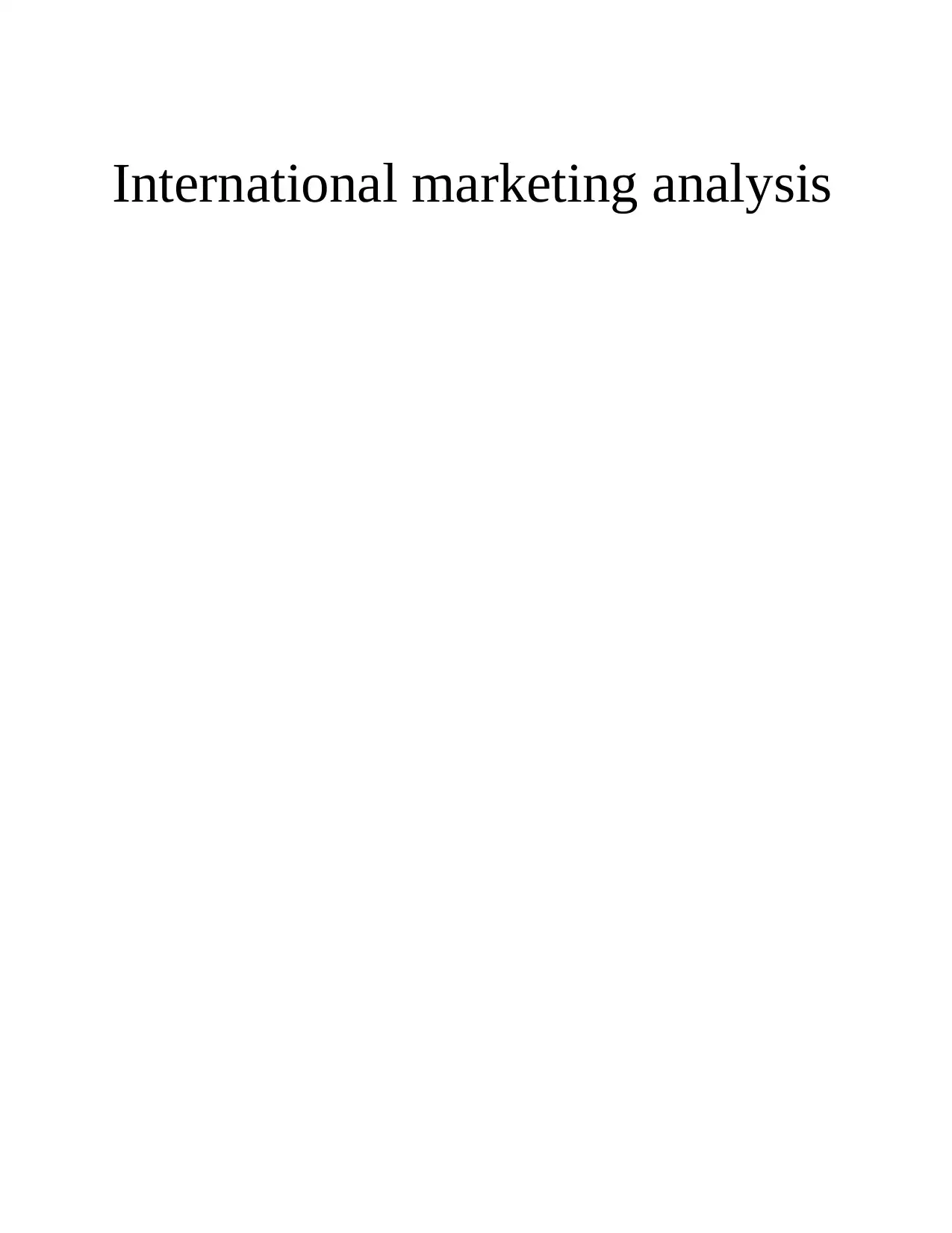
International marketing analysis
Paraphrase This Document
Need a fresh take? Get an instant paraphrase of this document with our AI Paraphraser

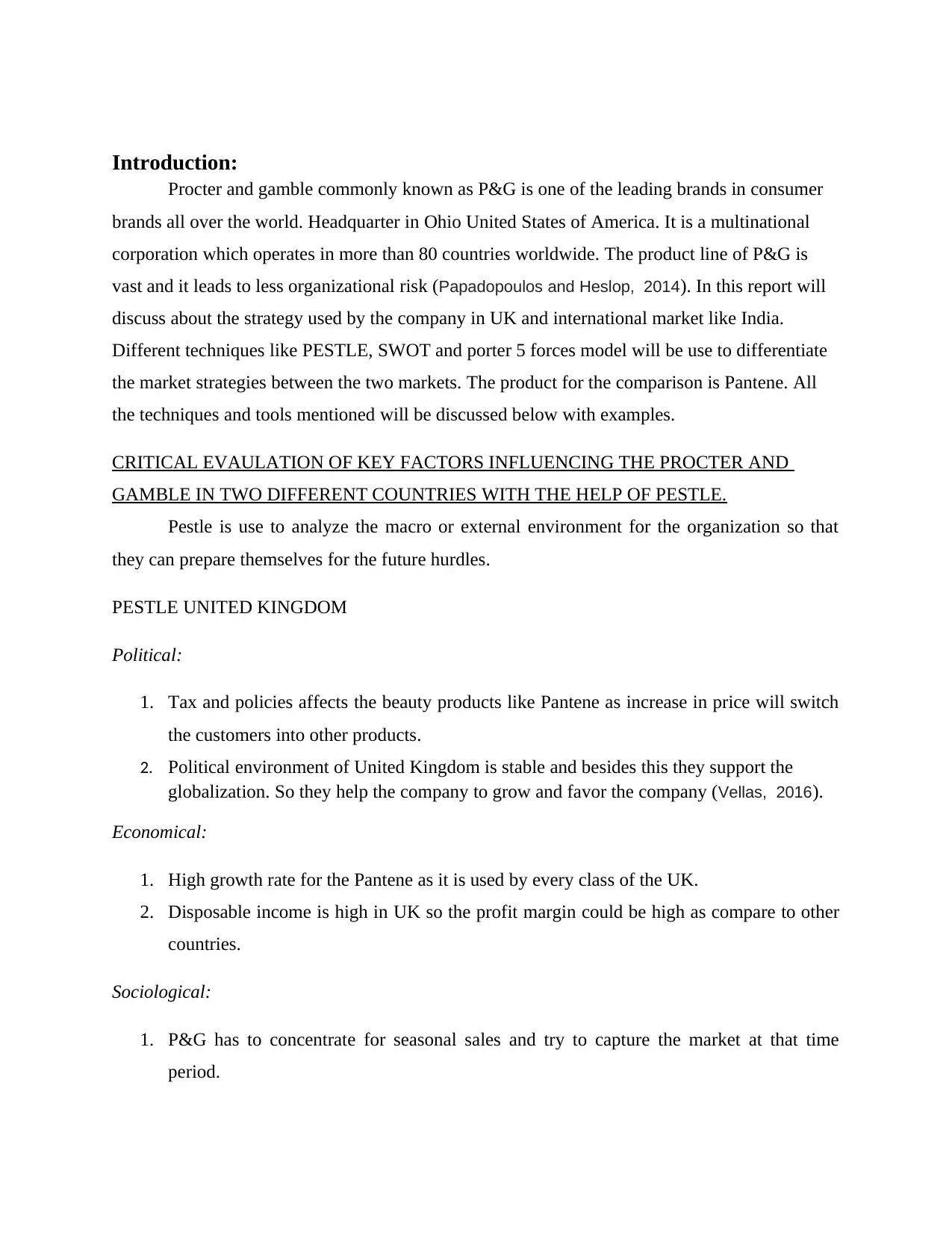
Introduction:
Procter and gamble commonly known as P&G is one of the leading brands in consumer
brands all over the world. Headquarter in Ohio United States of America. It is a multinational
corporation which operates in more than 80 countries worldwide. The product line of P&G is
vast and it leads to less organizational risk (Papadopoulos and Heslop, 2014). In this report will
discuss about the strategy used by the company in UK and international market like India.
Different techniques like PESTLE, SWOT and porter 5 forces model will be use to differentiate
the market strategies between the two markets. The product for the comparison is Pantene. All
the techniques and tools mentioned will be discussed below with examples.
CRITICAL EVAULATION OF KEY FACTORS INFLUENCING THE PROCTER AND
GAMBLE IN TWO DIFFERENT COUNTRIES WITH THE HELP OF PESTLE.
Pestle is use to analyze the macro or external environment for the organization so that
they can prepare themselves for the future hurdles.
PESTLE UNITED KINGDOM
Political:
1. Tax and policies affects the beauty products like Pantene as increase in price will switch
the customers into other products.
2. Political environment of United Kingdom is stable and besides this they support the
globalization. So they help the company to grow and favor the company (Vellas, 2016).
Economical:
1. High growth rate for the Pantene as it is used by every class of the UK.
2. Disposable income is high in UK so the profit margin could be high as compare to other
countries.
Sociological:
1. P&G has to concentrate for seasonal sales and try to capture the market at that time
period.
Procter and gamble commonly known as P&G is one of the leading brands in consumer
brands all over the world. Headquarter in Ohio United States of America. It is a multinational
corporation which operates in more than 80 countries worldwide. The product line of P&G is
vast and it leads to less organizational risk (Papadopoulos and Heslop, 2014). In this report will
discuss about the strategy used by the company in UK and international market like India.
Different techniques like PESTLE, SWOT and porter 5 forces model will be use to differentiate
the market strategies between the two markets. The product for the comparison is Pantene. All
the techniques and tools mentioned will be discussed below with examples.
CRITICAL EVAULATION OF KEY FACTORS INFLUENCING THE PROCTER AND
GAMBLE IN TWO DIFFERENT COUNTRIES WITH THE HELP OF PESTLE.
Pestle is use to analyze the macro or external environment for the organization so that
they can prepare themselves for the future hurdles.
PESTLE UNITED KINGDOM
Political:
1. Tax and policies affects the beauty products like Pantene as increase in price will switch
the customers into other products.
2. Political environment of United Kingdom is stable and besides this they support the
globalization. So they help the company to grow and favor the company (Vellas, 2016).
Economical:
1. High growth rate for the Pantene as it is used by every class of the UK.
2. Disposable income is high in UK so the profit margin could be high as compare to other
countries.
Sociological:
1. P&G has to concentrate for seasonal sales and try to capture the market at that time
period.
⊘ This is a preview!⊘
Do you want full access?
Subscribe today to unlock all pages.

Trusted by 1+ million students worldwide
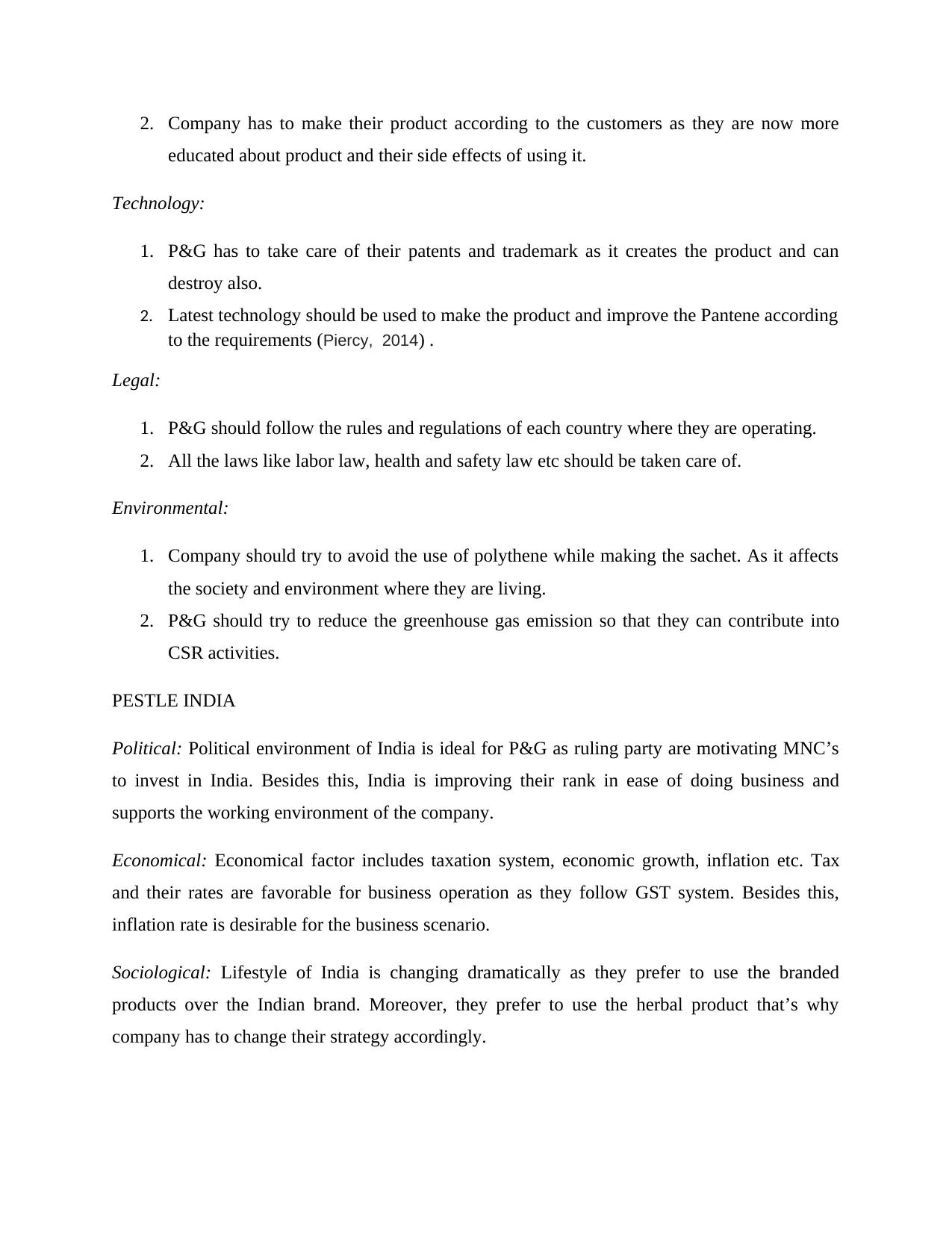
2. Company has to make their product according to the customers as they are now more
educated about product and their side effects of using it.
Technology:
1. P&G has to take care of their patents and trademark as it creates the product and can
destroy also.
2. Latest technology should be used to make the product and improve the Pantene according
to the requirements (Piercy, 2014) .
Legal:
1. P&G should follow the rules and regulations of each country where they are operating.
2. All the laws like labor law, health and safety law etc should be taken care of.
Environmental:
1. Company should try to avoid the use of polythene while making the sachet. As it affects
the society and environment where they are living.
2. P&G should try to reduce the greenhouse gas emission so that they can contribute into
CSR activities.
PESTLE INDIA
Political: Political environment of India is ideal for P&G as ruling party are motivating MNC’s
to invest in India. Besides this, India is improving their rank in ease of doing business and
supports the working environment of the company.
Economical: Economical factor includes taxation system, economic growth, inflation etc. Tax
and their rates are favorable for business operation as they follow GST system. Besides this,
inflation rate is desirable for the business scenario.
Sociological: Lifestyle of India is changing dramatically as they prefer to use the branded
products over the Indian brand. Moreover, they prefer to use the herbal product that’s why
company has to change their strategy accordingly.
educated about product and their side effects of using it.
Technology:
1. P&G has to take care of their patents and trademark as it creates the product and can
destroy also.
2. Latest technology should be used to make the product and improve the Pantene according
to the requirements (Piercy, 2014) .
Legal:
1. P&G should follow the rules and regulations of each country where they are operating.
2. All the laws like labor law, health and safety law etc should be taken care of.
Environmental:
1. Company should try to avoid the use of polythene while making the sachet. As it affects
the society and environment where they are living.
2. P&G should try to reduce the greenhouse gas emission so that they can contribute into
CSR activities.
PESTLE INDIA
Political: Political environment of India is ideal for P&G as ruling party are motivating MNC’s
to invest in India. Besides this, India is improving their rank in ease of doing business and
supports the working environment of the company.
Economical: Economical factor includes taxation system, economic growth, inflation etc. Tax
and their rates are favorable for business operation as they follow GST system. Besides this,
inflation rate is desirable for the business scenario.
Sociological: Lifestyle of India is changing dramatically as they prefer to use the branded
products over the Indian brand. Moreover, they prefer to use the herbal product that’s why
company has to change their strategy accordingly.
Paraphrase This Document
Need a fresh take? Get an instant paraphrase of this document with our AI Paraphraser
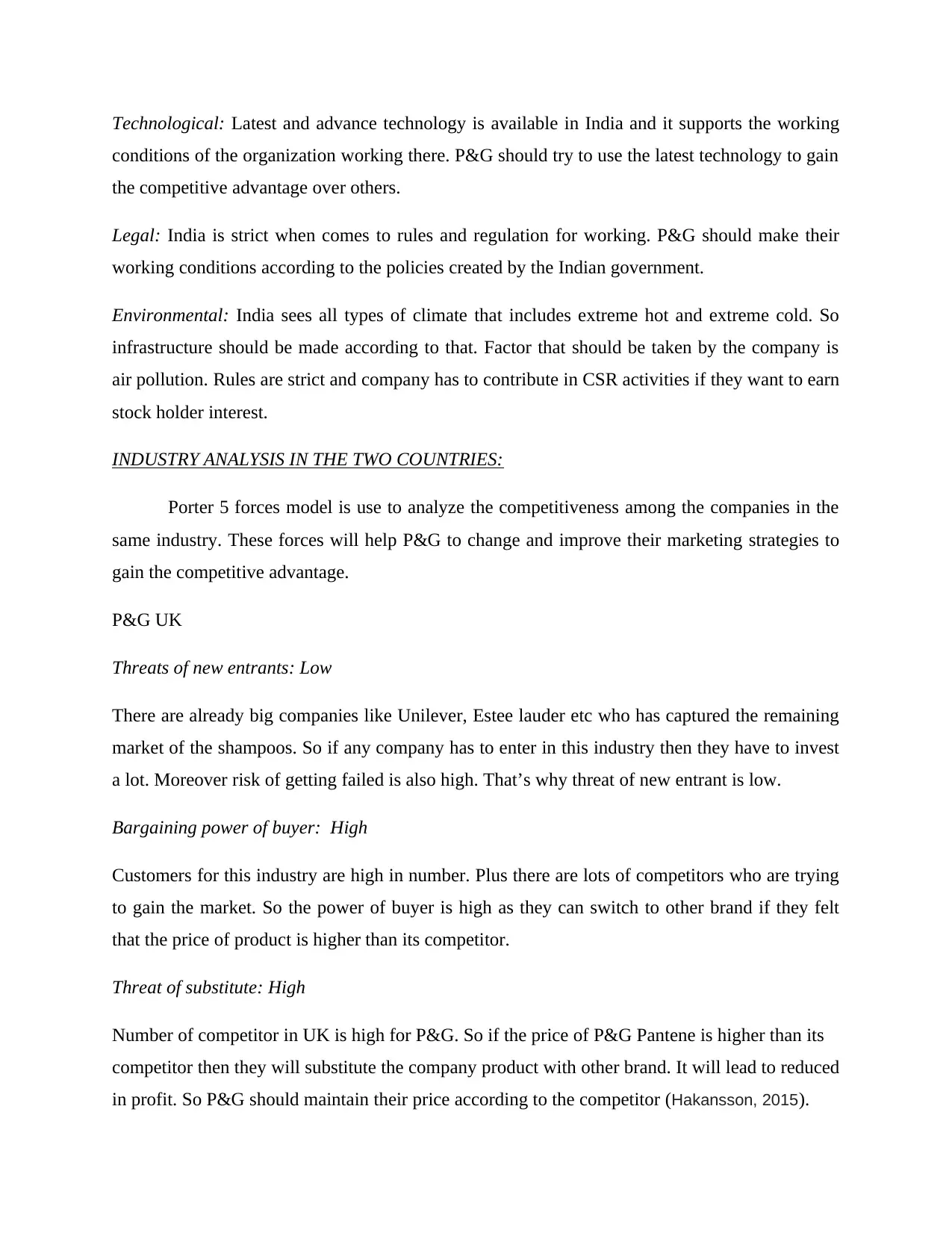
Technological: Latest and advance technology is available in India and it supports the working
conditions of the organization working there. P&G should try to use the latest technology to gain
the competitive advantage over others.
Legal: India is strict when comes to rules and regulation for working. P&G should make their
working conditions according to the policies created by the Indian government.
Environmental: India sees all types of climate that includes extreme hot and extreme cold. So
infrastructure should be made according to that. Factor that should be taken by the company is
air pollution. Rules are strict and company has to contribute in CSR activities if they want to earn
stock holder interest.
INDUSTRY ANALYSIS IN THE TWO COUNTRIES:
Porter 5 forces model is use to analyze the competitiveness among the companies in the
same industry. These forces will help P&G to change and improve their marketing strategies to
gain the competitive advantage.
P&G UK
Threats of new entrants: Low
There are already big companies like Unilever, Estee lauder etc who has captured the remaining
market of the shampoos. So if any company has to enter in this industry then they have to invest
a lot. Moreover risk of getting failed is also high. That’s why threat of new entrant is low.
Bargaining power of buyer: High
Customers for this industry are high in number. Plus there are lots of competitors who are trying
to gain the market. So the power of buyer is high as they can switch to other brand if they felt
that the price of product is higher than its competitor.
Threat of substitute: High
Number of competitor in UK is high for P&G. So if the price of P&G Pantene is higher than its
competitor then they will substitute the company product with other brand. It will lead to reduced
in profit. So P&G should maintain their price according to the competitor (Hakansson, 2015).
conditions of the organization working there. P&G should try to use the latest technology to gain
the competitive advantage over others.
Legal: India is strict when comes to rules and regulation for working. P&G should make their
working conditions according to the policies created by the Indian government.
Environmental: India sees all types of climate that includes extreme hot and extreme cold. So
infrastructure should be made according to that. Factor that should be taken by the company is
air pollution. Rules are strict and company has to contribute in CSR activities if they want to earn
stock holder interest.
INDUSTRY ANALYSIS IN THE TWO COUNTRIES:
Porter 5 forces model is use to analyze the competitiveness among the companies in the
same industry. These forces will help P&G to change and improve their marketing strategies to
gain the competitive advantage.
P&G UK
Threats of new entrants: Low
There are already big companies like Unilever, Estee lauder etc who has captured the remaining
market of the shampoos. So if any company has to enter in this industry then they have to invest
a lot. Moreover risk of getting failed is also high. That’s why threat of new entrant is low.
Bargaining power of buyer: High
Customers for this industry are high in number. Plus there are lots of competitors who are trying
to gain the market. So the power of buyer is high as they can switch to other brand if they felt
that the price of product is higher than its competitor.
Threat of substitute: High
Number of competitor in UK is high for P&G. So if the price of P&G Pantene is higher than its
competitor then they will substitute the company product with other brand. It will lead to reduced
in profit. So P&G should maintain their price according to the competitor (Hakansson, 2015).
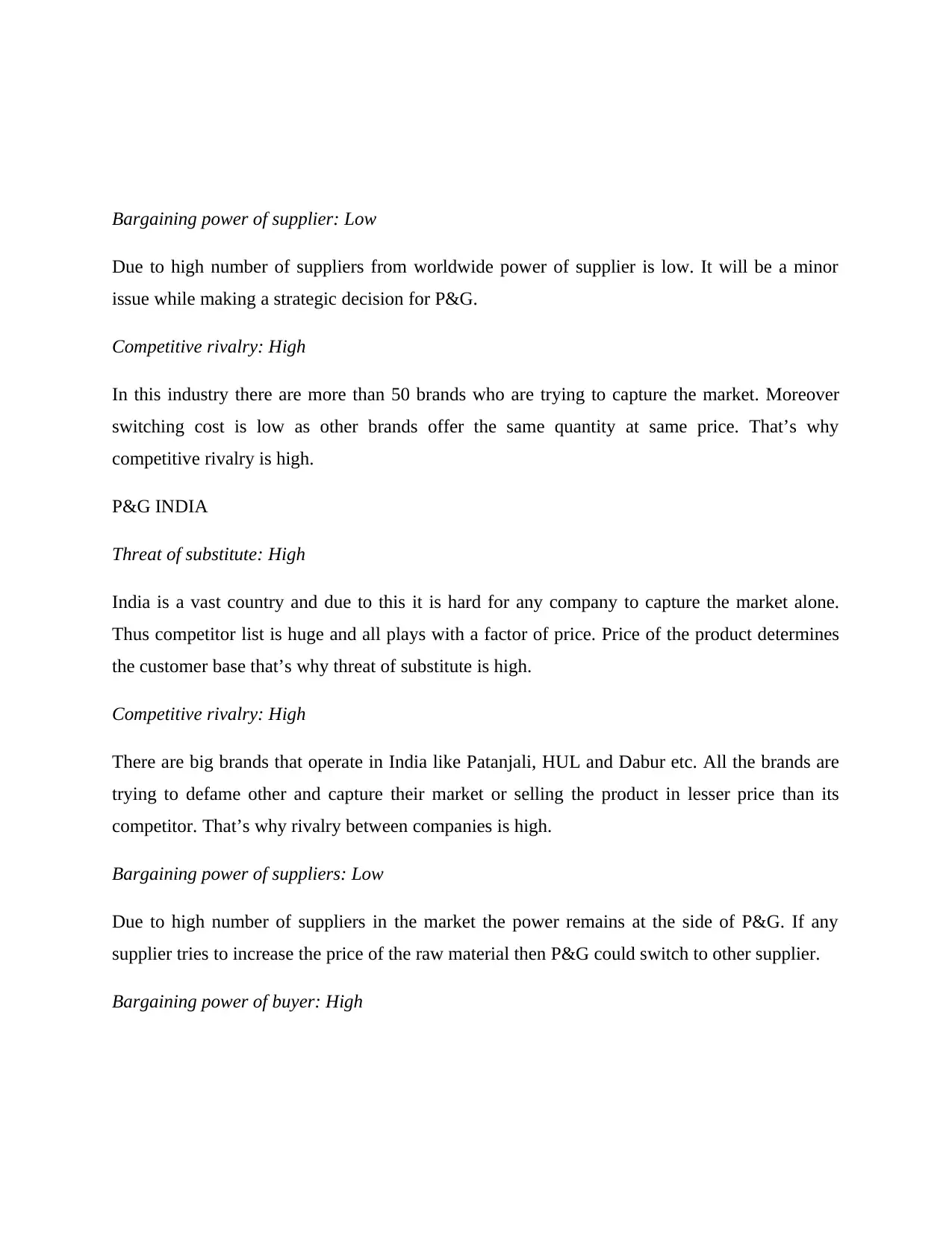
Bargaining power of supplier: Low
Due to high number of suppliers from worldwide power of supplier is low. It will be a minor
issue while making a strategic decision for P&G.
Competitive rivalry: High
In this industry there are more than 50 brands who are trying to capture the market. Moreover
switching cost is low as other brands offer the same quantity at same price. That’s why
competitive rivalry is high.
P&G INDIA
Threat of substitute: High
India is a vast country and due to this it is hard for any company to capture the market alone.
Thus competitor list is huge and all plays with a factor of price. Price of the product determines
the customer base that’s why threat of substitute is high.
Competitive rivalry: High
There are big brands that operate in India like Patanjali, HUL and Dabur etc. All the brands are
trying to defame other and capture their market or selling the product in lesser price than its
competitor. That’s why rivalry between companies is high.
Bargaining power of suppliers: Low
Due to high number of suppliers in the market the power remains at the side of P&G. If any
supplier tries to increase the price of the raw material then P&G could switch to other supplier.
Bargaining power of buyer: High
Due to high number of suppliers from worldwide power of supplier is low. It will be a minor
issue while making a strategic decision for P&G.
Competitive rivalry: High
In this industry there are more than 50 brands who are trying to capture the market. Moreover
switching cost is low as other brands offer the same quantity at same price. That’s why
competitive rivalry is high.
P&G INDIA
Threat of substitute: High
India is a vast country and due to this it is hard for any company to capture the market alone.
Thus competitor list is huge and all plays with a factor of price. Price of the product determines
the customer base that’s why threat of substitute is high.
Competitive rivalry: High
There are big brands that operate in India like Patanjali, HUL and Dabur etc. All the brands are
trying to defame other and capture their market or selling the product in lesser price than its
competitor. That’s why rivalry between companies is high.
Bargaining power of suppliers: Low
Due to high number of suppliers in the market the power remains at the side of P&G. If any
supplier tries to increase the price of the raw material then P&G could switch to other supplier.
Bargaining power of buyer: High
⊘ This is a preview!⊘
Do you want full access?
Subscribe today to unlock all pages.

Trusted by 1+ million students worldwide
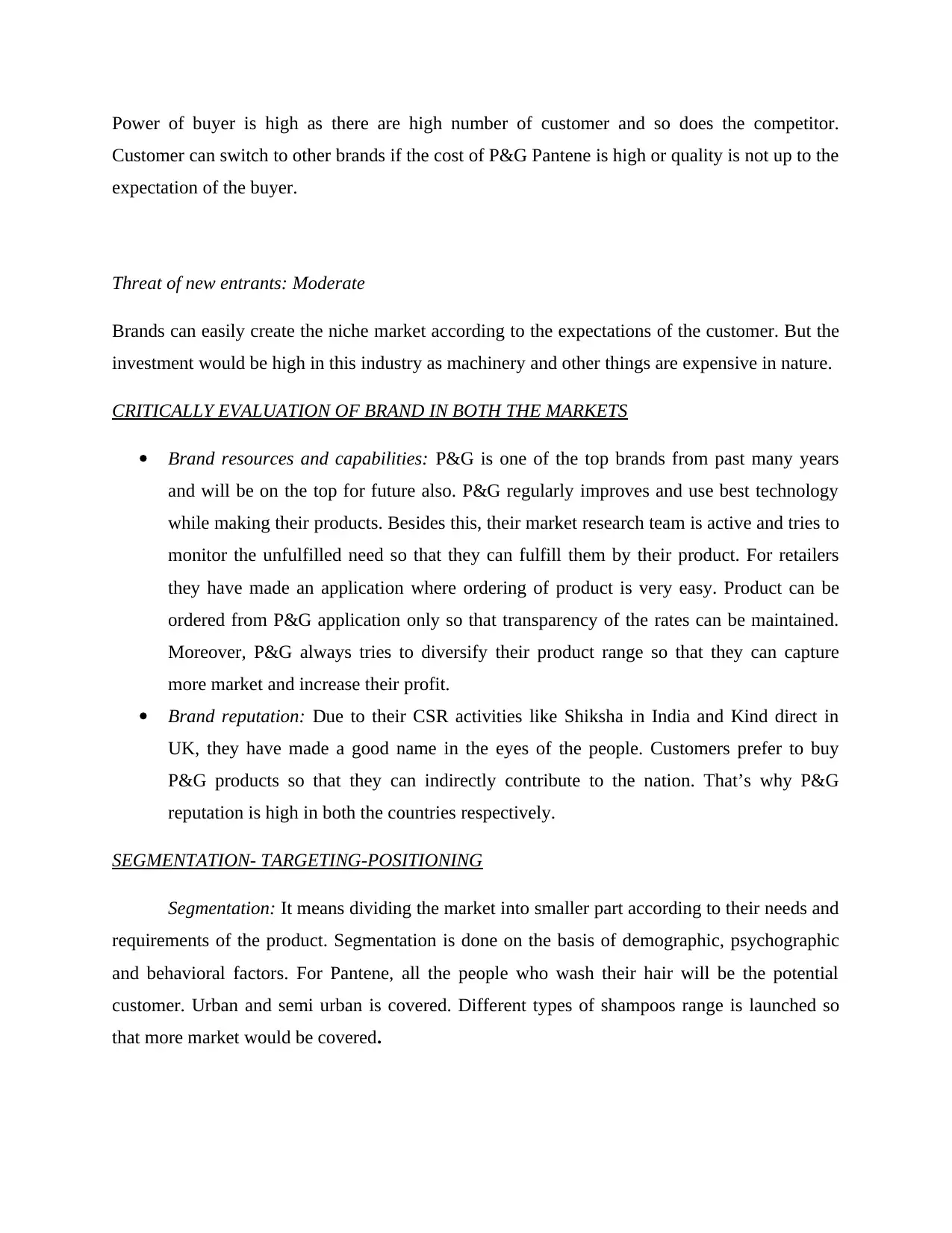
Power of buyer is high as there are high number of customer and so does the competitor.
Customer can switch to other brands if the cost of P&G Pantene is high or quality is not up to the
expectation of the buyer.
Threat of new entrants: Moderate
Brands can easily create the niche market according to the expectations of the customer. But the
investment would be high in this industry as machinery and other things are expensive in nature.
CRITICALLY EVALUATION OF BRAND IN BOTH THE MARKETS
Brand resources and capabilities: P&G is one of the top brands from past many years
and will be on the top for future also. P&G regularly improves and use best technology
while making their products. Besides this, their market research team is active and tries to
monitor the unfulfilled need so that they can fulfill them by their product. For retailers
they have made an application where ordering of product is very easy. Product can be
ordered from P&G application only so that transparency of the rates can be maintained.
Moreover, P&G always tries to diversify their product range so that they can capture
more market and increase their profit.
Brand reputation: Due to their CSR activities like Shiksha in India and Kind direct in
UK, they have made a good name in the eyes of the people. Customers prefer to buy
P&G products so that they can indirectly contribute to the nation. That’s why P&G
reputation is high in both the countries respectively.
SEGMENTATION- TARGETING-POSITIONING
Segmentation: It means dividing the market into smaller part according to their needs and
requirements of the product. Segmentation is done on the basis of demographic, psychographic
and behavioral factors. For Pantene, all the people who wash their hair will be the potential
customer. Urban and semi urban is covered. Different types of shampoos range is launched so
that more market would be covered.
Customer can switch to other brands if the cost of P&G Pantene is high or quality is not up to the
expectation of the buyer.
Threat of new entrants: Moderate
Brands can easily create the niche market according to the expectations of the customer. But the
investment would be high in this industry as machinery and other things are expensive in nature.
CRITICALLY EVALUATION OF BRAND IN BOTH THE MARKETS
Brand resources and capabilities: P&G is one of the top brands from past many years
and will be on the top for future also. P&G regularly improves and use best technology
while making their products. Besides this, their market research team is active and tries to
monitor the unfulfilled need so that they can fulfill them by their product. For retailers
they have made an application where ordering of product is very easy. Product can be
ordered from P&G application only so that transparency of the rates can be maintained.
Moreover, P&G always tries to diversify their product range so that they can capture
more market and increase their profit.
Brand reputation: Due to their CSR activities like Shiksha in India and Kind direct in
UK, they have made a good name in the eyes of the people. Customers prefer to buy
P&G products so that they can indirectly contribute to the nation. That’s why P&G
reputation is high in both the countries respectively.
SEGMENTATION- TARGETING-POSITIONING
Segmentation: It means dividing the market into smaller part according to their needs and
requirements of the product. Segmentation is done on the basis of demographic, psychographic
and behavioral factors. For Pantene, all the people who wash their hair will be the potential
customer. Urban and semi urban is covered. Different types of shampoos range is launched so
that more market would be covered.
Paraphrase This Document
Need a fresh take? Get an instant paraphrase of this document with our AI Paraphraser
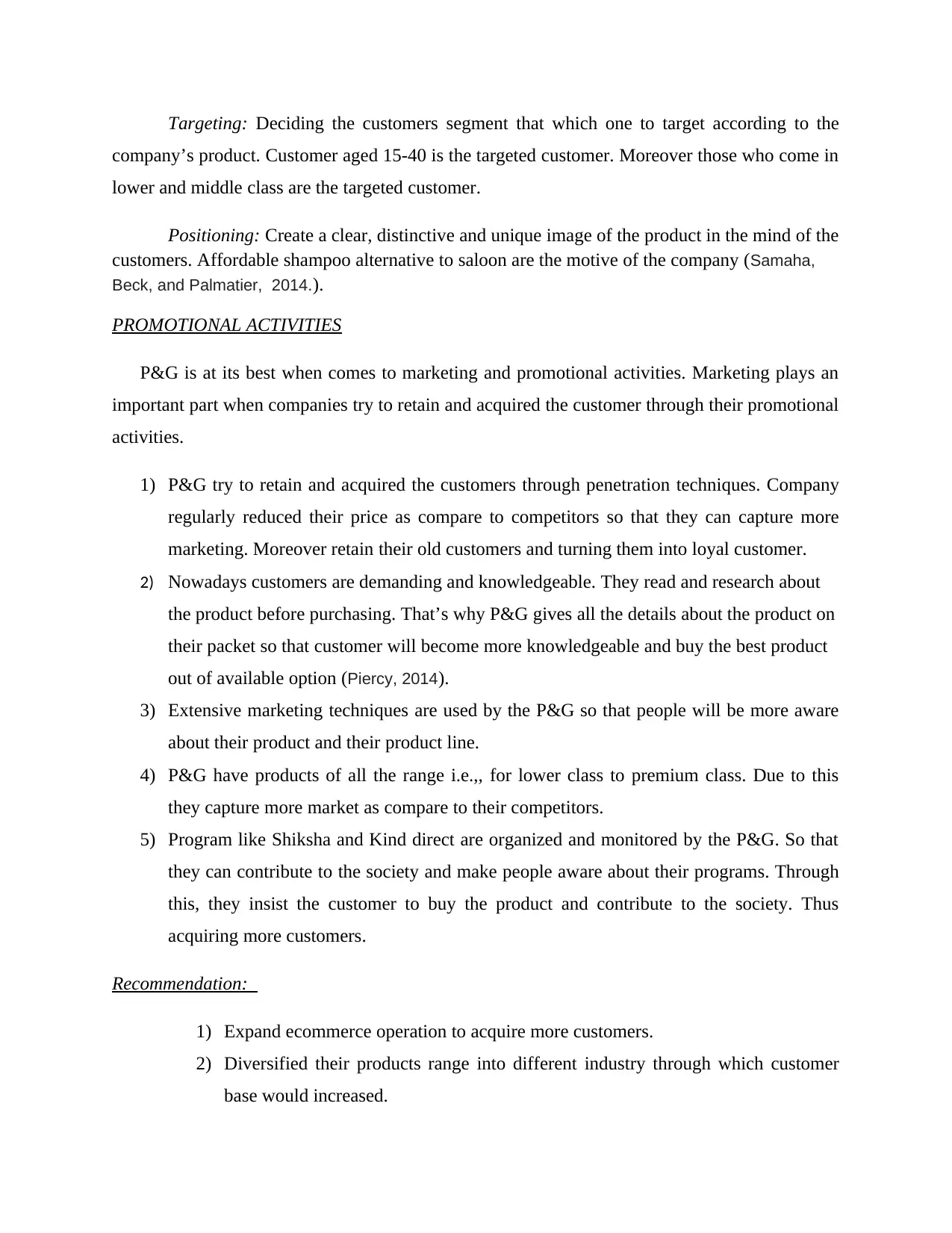
Targeting: Deciding the customers segment that which one to target according to the
company’s product. Customer aged 15-40 is the targeted customer. Moreover those who come in
lower and middle class are the targeted customer.
Positioning: Create a clear, distinctive and unique image of the product in the mind of the
customers. Affordable shampoo alternative to saloon are the motive of the company (Samaha,
Beck, and Palmatier, 2014.).
PROMOTIONAL ACTIVITIES
P&G is at its best when comes to marketing and promotional activities. Marketing plays an
important part when companies try to retain and acquired the customer through their promotional
activities.
1) P&G try to retain and acquired the customers through penetration techniques. Company
regularly reduced their price as compare to competitors so that they can capture more
marketing. Moreover retain their old customers and turning them into loyal customer.
2) Nowadays customers are demanding and knowledgeable. They read and research about
the product before purchasing. That’s why P&G gives all the details about the product on
their packet so that customer will become more knowledgeable and buy the best product
out of available option (Piercy, 2014).
3) Extensive marketing techniques are used by the P&G so that people will be more aware
about their product and their product line.
4) P&G have products of all the range i.e.,, for lower class to premium class. Due to this
they capture more market as compare to their competitors.
5) Program like Shiksha and Kind direct are organized and monitored by the P&G. So that
they can contribute to the society and make people aware about their programs. Through
this, they insist the customer to buy the product and contribute to the society. Thus
acquiring more customers.
Recommendation:
1) Expand ecommerce operation to acquire more customers.
2) Diversified their products range into different industry through which customer
base would increased.
company’s product. Customer aged 15-40 is the targeted customer. Moreover those who come in
lower and middle class are the targeted customer.
Positioning: Create a clear, distinctive and unique image of the product in the mind of the
customers. Affordable shampoo alternative to saloon are the motive of the company (Samaha,
Beck, and Palmatier, 2014.).
PROMOTIONAL ACTIVITIES
P&G is at its best when comes to marketing and promotional activities. Marketing plays an
important part when companies try to retain and acquired the customer through their promotional
activities.
1) P&G try to retain and acquired the customers through penetration techniques. Company
regularly reduced their price as compare to competitors so that they can capture more
marketing. Moreover retain their old customers and turning them into loyal customer.
2) Nowadays customers are demanding and knowledgeable. They read and research about
the product before purchasing. That’s why P&G gives all the details about the product on
their packet so that customer will become more knowledgeable and buy the best product
out of available option (Piercy, 2014).
3) Extensive marketing techniques are used by the P&G so that people will be more aware
about their product and their product line.
4) P&G have products of all the range i.e.,, for lower class to premium class. Due to this
they capture more market as compare to their competitors.
5) Program like Shiksha and Kind direct are organized and monitored by the P&G. So that
they can contribute to the society and make people aware about their programs. Through
this, they insist the customer to buy the product and contribute to the society. Thus
acquiring more customers.
Recommendation:
1) Expand ecommerce operation to acquire more customers.
2) Diversified their products range into different industry through which customer
base would increased.
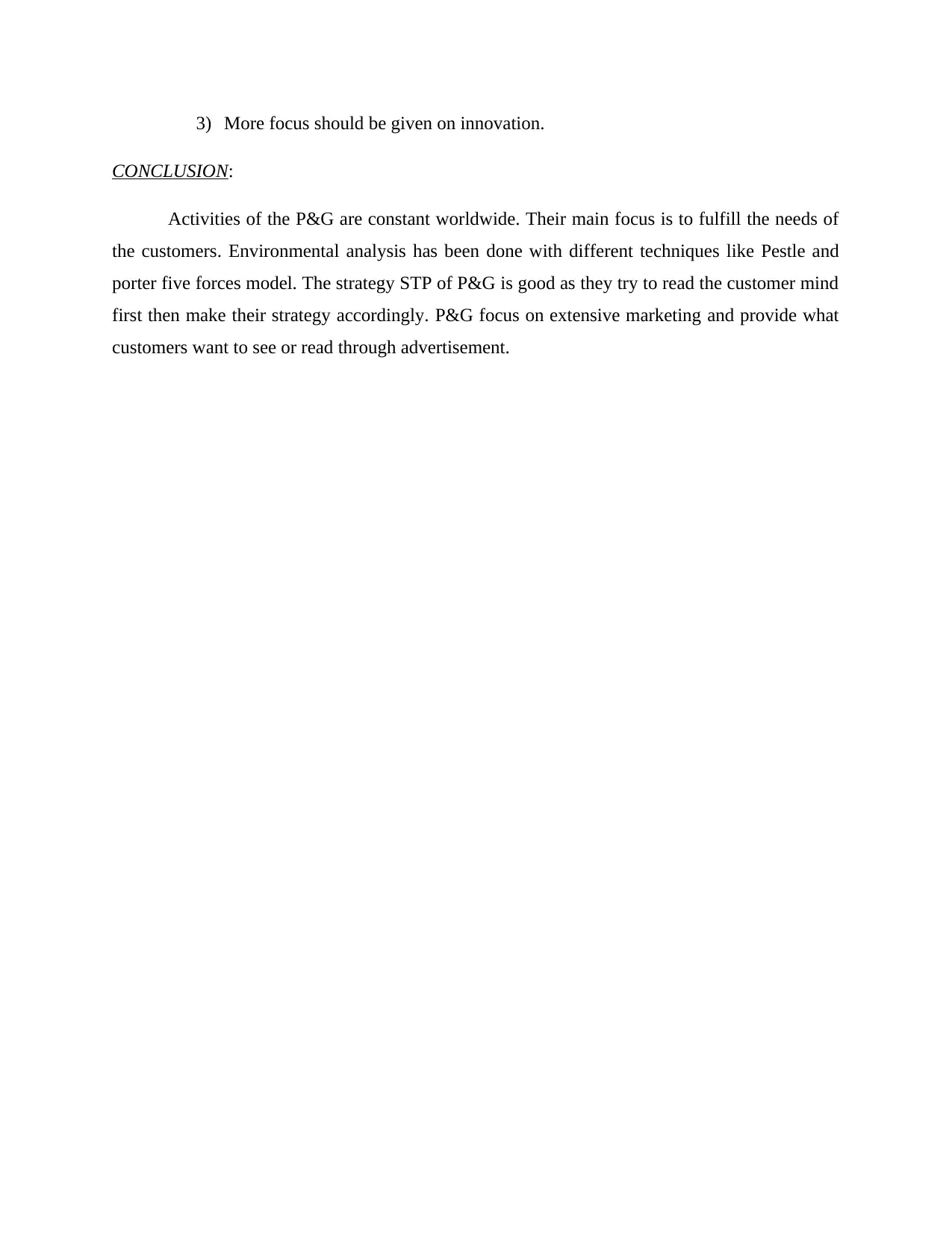
3) More focus should be given on innovation.
CONCLUSION:
Activities of the P&G are constant worldwide. Their main focus is to fulfill the needs of
the customers. Environmental analysis has been done with different techniques like Pestle and
porter five forces model. The strategy STP of P&G is good as they try to read the customer mind
first then make their strategy accordingly. P&G focus on extensive marketing and provide what
customers want to see or read through advertisement.
CONCLUSION:
Activities of the P&G are constant worldwide. Their main focus is to fulfill the needs of
the customers. Environmental analysis has been done with different techniques like Pestle and
porter five forces model. The strategy STP of P&G is good as they try to read the customer mind
first then make their strategy accordingly. P&G focus on extensive marketing and provide what
customers want to see or read through advertisement.
⊘ This is a preview!⊘
Do you want full access?
Subscribe today to unlock all pages.

Trusted by 1+ million students worldwide
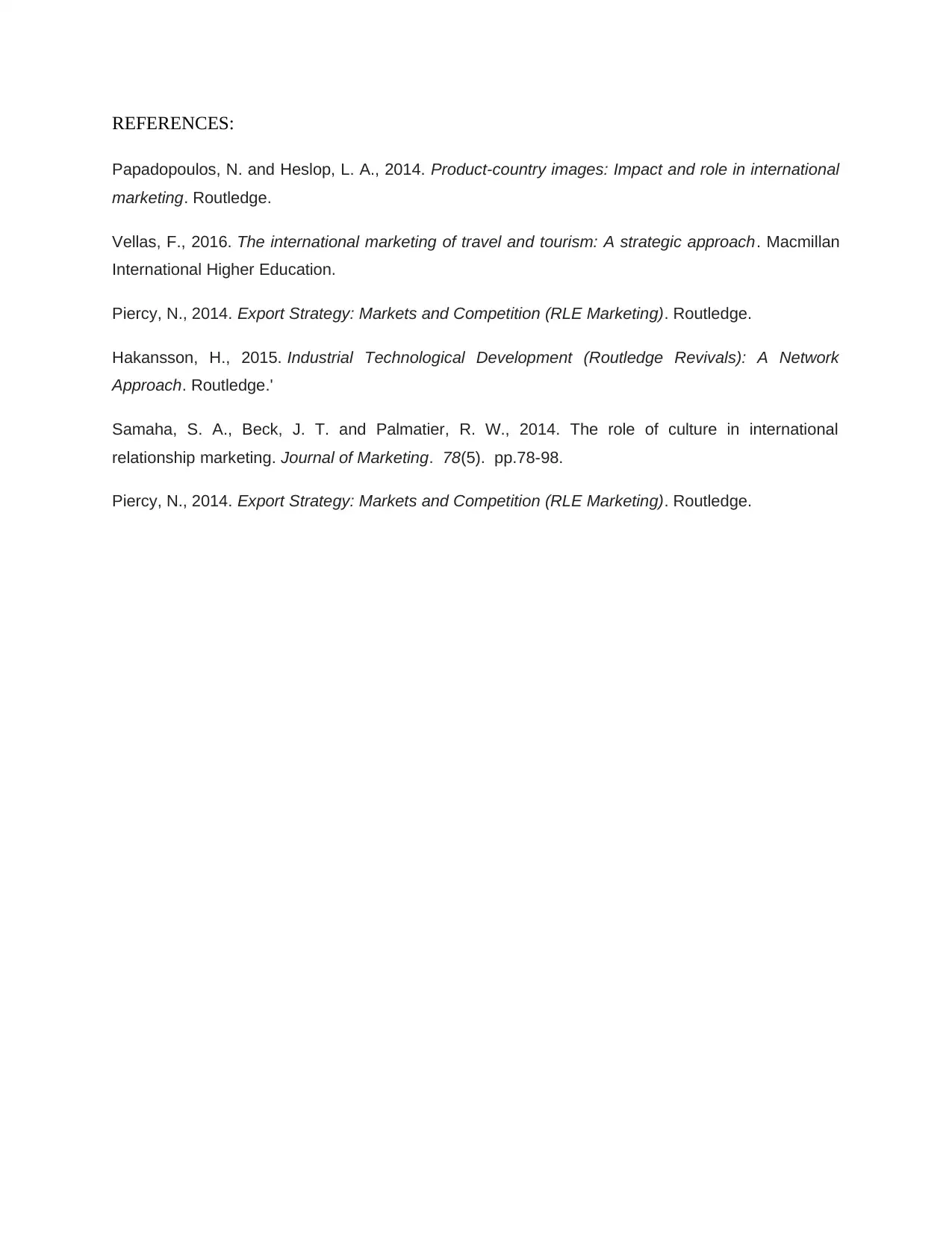
REFERENCES:
Papadopoulos, N. and Heslop, L. A., 2014. Product-country images: Impact and role in international
marketing. Routledge.
Vellas, F., 2016. The international marketing of travel and tourism: A strategic approach. Macmillan
International Higher Education.
Piercy, N., 2014. Export Strategy: Markets and Competition (RLE Marketing). Routledge.
Hakansson, H., 2015. Industrial Technological Development (Routledge Revivals): A Network
Approach. Routledge.'
Samaha, S. A., Beck, J. T. and Palmatier, R. W., 2014. The role of culture in international
relationship marketing. Journal of Marketing. 78(5). pp.78-98.
Piercy, N., 2014. Export Strategy: Markets and Competition (RLE Marketing). Routledge.
Papadopoulos, N. and Heslop, L. A., 2014. Product-country images: Impact and role in international
marketing. Routledge.
Vellas, F., 2016. The international marketing of travel and tourism: A strategic approach. Macmillan
International Higher Education.
Piercy, N., 2014. Export Strategy: Markets and Competition (RLE Marketing). Routledge.
Hakansson, H., 2015. Industrial Technological Development (Routledge Revivals): A Network
Approach. Routledge.'
Samaha, S. A., Beck, J. T. and Palmatier, R. W., 2014. The role of culture in international
relationship marketing. Journal of Marketing. 78(5). pp.78-98.
Piercy, N., 2014. Export Strategy: Markets and Competition (RLE Marketing). Routledge.
1 out of 10
Related Documents
Your All-in-One AI-Powered Toolkit for Academic Success.
+13062052269
info@desklib.com
Available 24*7 on WhatsApp / Email
![[object Object]](/_next/static/media/star-bottom.7253800d.svg)
Unlock your academic potential
Copyright © 2020–2025 A2Z Services. All Rights Reserved. Developed and managed by ZUCOL.




